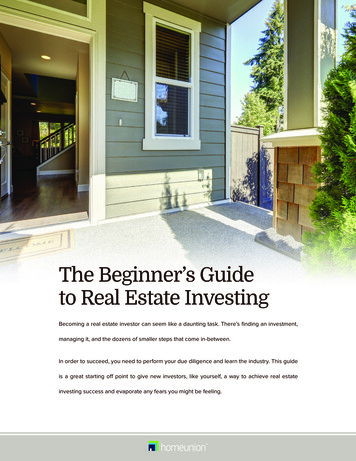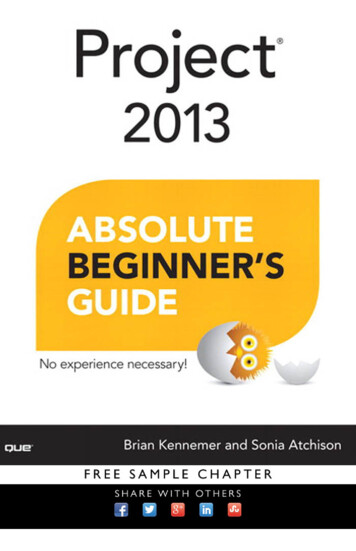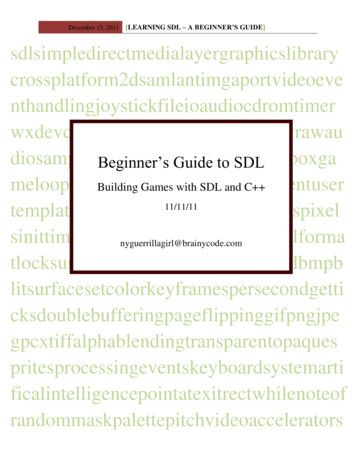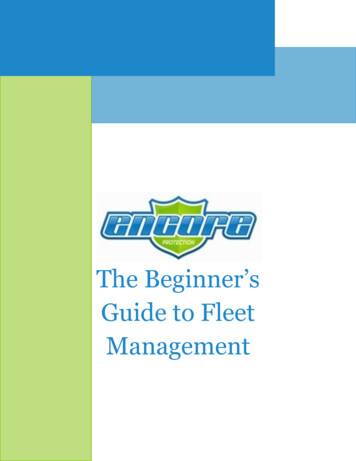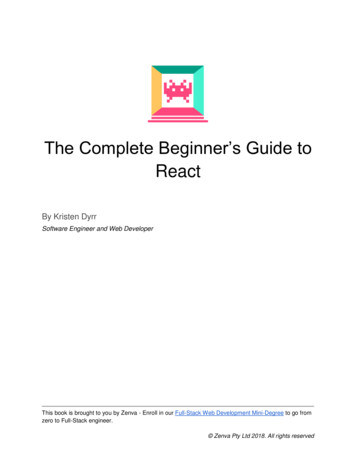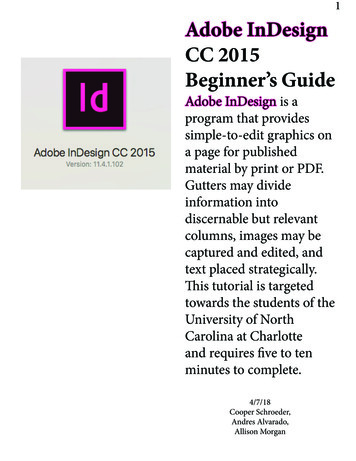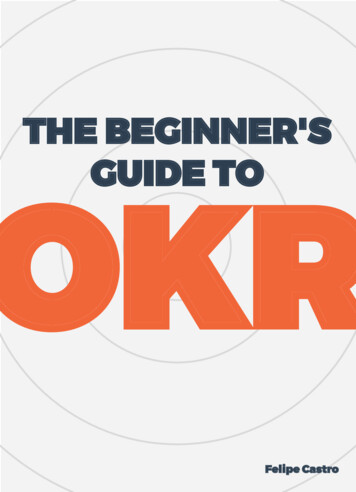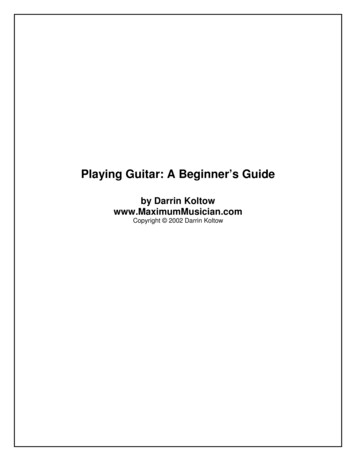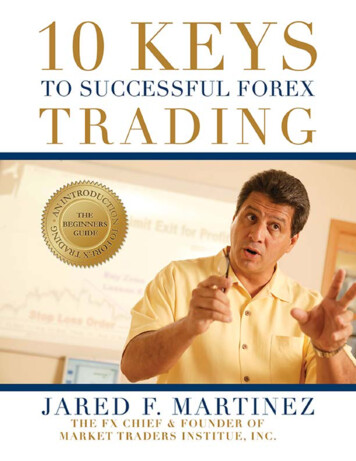
Transcription
A Beginner’s Guide to Forex Trading:The 10 Keys to Forex TradingBY JARED MARTINEZ
RADINGCopyright 2019 by Jared F. Martinez, FXChief ALL RIGHTS RESERVED: No part of this book may be reproduced or transmitted inany form by any means, electronic or mechanical, including photocopying, recordingor by any information storage or retrieval systems, without the express writtenpermission from the author and publisher. All materials contained herein have beencopyrighted. Reproduction will be in violation of all Copyright Laws. Violators will beprosecuted.While attempts have been made to verify the accuracy of information provided in thismanual, neither the author nor the publisher assumes responsibility for errors,inaccuracies, or omissions.Information contained in this e-book is provided for the sole purpose of assistingtraders to make independent investment decisions There are no claims by theAuthor, Jared F. Martinez, or Market Traders Institute, Inc., ForexTips.com or any ofits directors, employees, and affiliated instructors that the trading strategies ormethodologies in this e-book will result in profits and will not result in losses. This ebook does not guarantee to produce profits. Currency trading on the FOREX andtrading results in general vary from individual to individual and may not be suitablefor everyone. Any opinions, strategies, techniques, methodologies, research,analysis, prices, or other information contained in this e-book are provided asgeneral market commentary, for educational purposes only, and does not constituteinvestment advice or a solicitation to buy or sell any Forex contract or securities ofany type. Jared F. Martinez, Market Traders Institute, Inc., ForexTips.com or any ofits directors, employees, and affiliated instructors will not accept liability for any lossor damage, including without limitation any loss of profit, which may arise directly orindirectly from use of or reliance on such information.You agree to use this e-book and the information contained within at your own risk.By downloading this manual, you confirm your agreement with the terms above,confirm and exempt the author, publisher, company, and instructors from anyliabilities or litigation.Market Traders Institute, Inc.3900 Millenia Blvd., Suite 200Orlando, Florida, 32839www.MarketTraders.comHave questions?USA: (407) 740-0900Toll-free: (800) 866-7431Register for a FREE Forex Webinar!Sign up for a LIVE! Webinar at www.markettraders.com/forex-book/webinar/ 2019 MARKET TRADERS INSTITUTE2
RADINGThe 10 Keys to Forex TradingKey 1: What is the Forex?Key 2: Trading Japanese CandlesticksKey 3: Entering the Forex MarketKey 4: The Trend is Your Friend Until it BendsKey 5: Trading Consolidation and FundamentalsKey 6: Equity ManagementKey 7: The Fibonacci SecretKey 8: So You Want to Be a Forex TraderKey 9: You Better Find a Forex MentorKey 10: Common Mistakes to Avoid and Persist Until You Succeed! 2019 MARKET TRADERS INSTITUTE3
RADINGKEY 1: What is the Forex?A brief history of the Forex market; how it all began:Bretton Woods AccordThe modern foreign exchange, or Forex market as we know it today, was putinto play around 1973. The establishment of the Bretton Woods Accord in1944 is generally accepted as the beginning of Forex market. It wasestablished to stabilize the global economy after World War II. It not onlycreated the concept of pegging currencies against one another, but also ledto the creation of the International Monetary Fund (IMF). Currencies fromaround the world were pegged against the U.S. dollar which were in turnpegged against the value of gold in an attempt to bring stability to globaleconomic events. In 1971, this act finally failed. However, it did manage tostabilize major economies of the world including those within the Americas,Europe and Asia.Free-Floating CurrenciesLate in 1971 and 1972, two more attempts were made to establish freefloating currencies against the U.S. dollar (namely the SmithsonianAgreement and the European Joint Float). The Smithsonian Agreement wasa modification of the Bretton Woods Accord with allowances for greatercurrency fluctuations while the European Joint Float aimed to reducedependence of European currencies upon the U.S. dollar. After the failure ofeach of these agreements, nations were allowed to peg their currencies tofreely float and were actually mandated to do so in 1978 by the IMF. Thefree-floating system managed to continue for several years after themandate, yet many countries with weaker currency values failed againstthose countries with stronger currency values.European Monetary SystemEuropean currencies were among those that were affected the most by thestrength of stronger currencies such as the U.S. dollar and the British pound.In July of 1978, the European Monetary System was created to counter thedependency on the U.S. dollar. It became increasingly clear by 1993 thatthis attempt had failed. Shortly thereafter, retail currency tradingopportunities, as we know them today, started to be enjoyed not only bythose familiar with the foreign exchange market, but also by small investorswilling to take similar risks like the banks and large financial institutions. 2019 MARKET TRADERS INSTITUTE4
RADINGThe Impact of DevaluationBy the late 1990s, stability issues increased in Europe as did major financialproblems in Asia. In 1997, there was a major currency crisis in SoutheastAsia. Many of the countries’ currencies were forced to float. The devaluationof currencies continued to plague the Asian currency markets. Confidence intrading the open Asian Forex markets was failing. Those currencies that hadcontinued to be valued relatively higher remained unchanged and kept theconcept of trading currencies out of those economically strong nations.The Introduction of the EuroThough Europeans were already very comfortable with the concept of Forextrading, this trading arena was still unfamiliar territory to the rest of theworld. The establishment of the European Union later gave birth to the euroin 1999. The euro was the first single currency used as legal tender for themember states in the European Union. It became the first currency able torival the historical leaders such as United States of America, Great Britain,and Japan in the foreign exchange market. It created the financial stabilitythat Europe and the Forex market had long desired.What is the Forex?“Forex” is an acronym for Foreign Exchange. It is a market where peopleexchange one country’s currency for another country’s currency. It is calledthe cash market or spot market. The spot market means trading right on thespot at whatever the price is at the moment the transaction occurs. Thismarket was established in 1971 as was previously mentioned. The Forexmarket is the arena in which the currencies of countries around the globeare exchanged for one another. Payments for import and export purchasesand the selling of goods or services between countries all flow through theforeign exchange market. This part of the Forex market is called theconsumer Forex market and this is where the majority of the daily volumetakes place.Prior to 1994, the Forex retail interbank market for small individualspeculative investors or traders was not available. A speculator investor isone who looks to make profit on price movements and is not looking to holdonto the currency for the long haul. With the previous minimum transactionsize, the smaller trader was excluded from being active within the market. Inthe late 1990s, retail market maker brokers (i.e. Forex CapitalMarkets/FXCM) were allowed to break down the large interbank units inorder to offer individual traders the opportunity to participate in the market. 2019 MARKET TRADERS INSTITUTE5
RADINGThe Forex market is the largest financial market in the world. The term“market” refers to a location where buyers and sellers are brought togetherto execute trading transactions. Nearly 4 trillion is traded on the Forexdaily. To give one a perspective of how big this market is, consider thefollowing: 300 billion each day is traded on the U.S. Treasury bond marketand 100 billion is traded on the U.S. stock market every financial day themarket is open. That is a total of 400 billion per day. The Forex tradesalmost ten times that volume. The Forex marketplace has no physicallocation. It is comprised of an electronic medium where transactions areplaced automatically through the Internet or via telephone. It is comprisedof approximately 4,500 world banks and retail brokers who all monitorcurrent prices, as they constantly change, and who execute transactions fortheir clients. Individual traders wanting to capture profit by speculating onprice changes get access to the market through a Forex broker.How Do Traders Get Paid?The word pip is an acronym for price interest point. The pip system monitorsprice movements in the market. Pips are usually measured in decimals.Depending on the pair being traded, pips are usually the last number of thedecimal in the price evaluation. A trader’s financial reward is measured inpips and those pips are converted into dollars. Most traders in the Forexmarket trade with what is called leverage. Trading with leverage means youare either borrowing or using someone else’s money to trade. You do this byposting a deposit with a broker who will let you use their money. Theminimum deposit, with some brokers, for trading with leverage is 1%, butthis number can go up as high as 4%.Trading on the Forex is done in currency lots. There are three types of lots.A micro lot is approximately 1,000 worth of a foreign currency. A mini lot isapproximately 10,000 worth of a foreign currency. A standard lot isapproximately 100,000 worth of a foreign currency. To trade on the Forexmarket, a margin account must be established with a currency broker. Thisis an account into which profits will be deposited and from which losses willbe deducted. These deposits and deductions are made instantly upon exitinga position.These three types of lots create different payouts per lot. A 100,000 unit iscalled a standard lot and pays approximately 10 per pip captured. A 10,000.00 unit is called a mini lot and pays approximately 1 per pipcaptured. A micro lot is a 1,000 unit and pays approximately 0.10 per pipcaptured. 2019 MARKET TRADERS INSTITUTE6
RADINGForex traders love the Forex market for its availability, liquidity, volatility,and diversification that leveraged trading allows.Learn How Pips Are CapturedYou can learn more about how pips are captured by attending a FREEonline webinar at www.markettraders.com/forex-book/webinar/ 2019 MARKET TRADERS INSTITUTE7
RADINGKey 2: Trading Japanese Candlesticks"Charts may be deaf and mute, yet they communicate verywell. Candlestick formations are the sign language of themarket. They tell the trader a large majority of the timewhere U-turns or reversals are and where the market isgoing."Most traders prefer learning how to read charts using what is called aJapanese candlestick. A Japanese candlestick monitors price movementsagainst time. When a trader looks at a chart, they have three viewingoptions: a line chart, a bar chart, or a Japanese candlestick chart. Bar chartsdominated the financial industry until just recently. Now even the world’sbest traders are using Japanese candlestick charts due to the stories theycan tell.One of my most amazing discoveries that turned my trading world aroundwas learning that the market talks and communicates through candlestickformations. It is one of the most amazing things I constantly see in themarket on a daily basis. It is somewhat like talking to a deaf person whodoes not verbally talk, yet they communicate via sign language. Learning toread candlestick formations opens up the world of trading every bit as muchas sign language opens up the communication world for the deaf.Reading a Japanese CandlestickJapanese candlestick charts are very unique in the way that they monitorprice movements during a certain period of time. As the candlesticks form,they begin to tell a story of the activity in the market as well as reflect themood of the market during a specific time frame. Candlesticks then becomethe sign language of the market as they communicate, via certainformations, the future potential moves of the market. Financial profits aremade from predicting correctly where the market will go, not where it hasbeen.Successful traders visually take the time to study and understand this signlanguage of the Forex market. Candlestick formations give off buy and sellsignals. They are communicating to the trader that it is time to enter themarket or it is time to get out. Our decision-making processes will bedirectly influenced by how clearly we understand these formations. 2019 MARKET TRADERS INSTITUTE8
RADINGJapanese candlestick formations can become the markets first sign of achange in direction, making a U-turn, or signaling a market reversal. Theywill appear in the form of a single candlestick or a combination ofcandlesticks. There are hundreds of formations, yet only a handful offormations carry substantial weight when looking for good market entrypoints. A good entry point is described as a location where the market goesyour way from the beginning. Let’s look at what a Japanese candlestick lookslike and how it forms.Japanese candlesticks can also tell you about a certain period of time. Forexample, you can set your charts to provide you with 5-minute candlesticks,10-minute candlesticks, 15-minute candlesticks, 30-minute candlesticks;even
Key 8: So You Want to Be a Forex Trader Key 9: You Better Find a Forex Mentor Key 10: Common Mistakes to Avoid and Persist Until You Succeed! 2019 MARKET TRADERS INSTITUTE . "FOREX"TRADING 2019 MARKET TRADERS INSTITUTE 4 KEY 1: What is the Forex? A brief history of the Forex market; how it all

